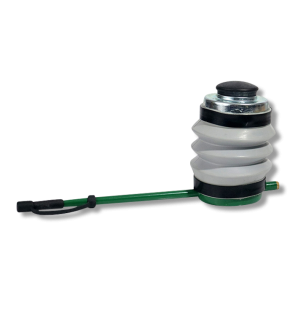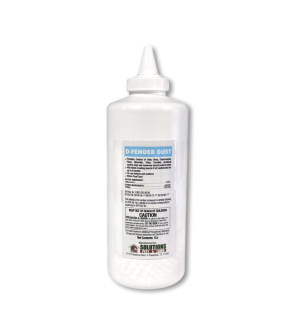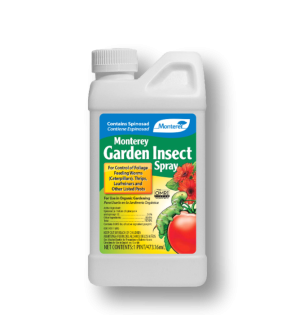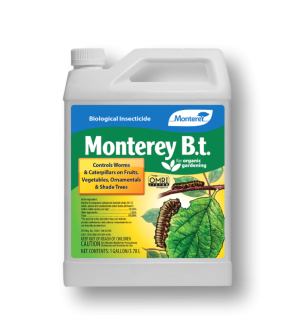Gain access to personalized product screening, the best pricing, rewards, and more!
Most Effective Products
Cabbage Looper Control: How to Get Rid of Cabbage Loopers
This page is an expert guide on getting rid of cabbage loopers in your yard using the products and methods our experienced pest control specialists suggested. Follow this guide and use the recommended products. We guarantee you will successfully eliminate cabbage loopers from your property.
Those little green caterpillars you see moving in a looping or inching motion are called cabbage loopers, also known as the cabbage worm. This smooth-moving caterpillar might look harmless, but it can destroy entire crops in just days.
It is often their caterpillar stages that cause the most problems. Feeding on the underside of leaves, cabbage loopers chew ragged holes, stunt plant growth, and leave behind droppings (frass) that spread disease. Worse, cabbage loopers are resilient to many pesticides, especially those containing the bacterium Bacillus thuringiensis (Bt).
Don't let the name fool you, cabbage loopers are not picky eaters limited to just cabbage but a broad range of plants, including lettuce, spinach, and even some flowers. This wide appetite range makes cabbage loopers an even bigger threat to farmers and homeowners.
Staying proactive with cabbage looper prevention and control can mean the difference between a successful harvest and a total loss. Follow along with the tips and products as suggested in our DIY guide for total cabbage looper control.
Identification

Before you can proceed with a treatment approach, you must be sure that the pest you are dealing with is a cabbage looper and not some other insect. Misidentification can lead to using the wrong treatment methods and products, which can end up being a waste of time and money. Here are some identifying characteristics of cabbage loopers:
- Cabbage loopers are light green caterpillars with several thin white stripes running lengthwise along their sides and back. They grow up to 2 inches long and have smooth, soft bodies that are slightly hairy and flattened.
- It has three pairs of true legs located near the head and three pairs of false legs, or prolegs, located farther back on the abdomen. This unique leg arrangement causes the caterpillars to move in a distinctive looping or arching motion.
- Eggs are pale green to yellowish when first laid and gradually turn white as they mature. Each egg is dome-shaped and about the size of a pinhead. They are typically are typically laid singly, often near the outer edges of the lower leaves of host crops.
- Adult cabbage looper moths are mottled grayish brown with a wingspan of about 1.5 inches. Each forewing typically displays silvery markings with one spot and the other spot shaped like a "V" or figure 8 with an open end.
Use the description and image above to help you properly identify the cabbage loopers on your property. If you are unsure, contact us, and we will try to assist you in identifying your pest problem correctly.
Inspection

Once you have confirmed that you are dealing with cabbage loopers, you can move on to inspection. During this phase, you will need to find out where the cabbage loopers are located and the places they are infesting. This will help you in determining where to focus your treatment application.
Where to Look
Cabbage loopers infest a wide range of vegetable crops, especially brassicas.
Common foliage they target are cabbage, broccoli, cauliflower, kale, radish, brussel sprouts, rutabaga, beets, celery, lettuce, peas, potatoes, spinach, squash, sweet potato, cucumber, pepper, watermelon plants, turnip, tomatoes, parsley, and other crucifererous crops.
Although they prefer vegetables, they may also feed on carnations and nasturtium.
What to Look For
From late April or early May through October, cabbage loopers can cause noticeable damage to crops by feeding on the leaves, mainly near the midrib on the upper surface, creating large, irregular, jagged holes.
While seedlings can occasionally be affected, most injury occurs after the plants begin to head. Early feeding starts on the underside of the leaves, where young larvae are unable to chew through completely, but as they grow, the caterpillars move toward the center of the plant, consuming more tissue and leaving behind larger holes.
Severe infestations can stunt crop heads or cause young foliage heads to die off. Cabbage loopers can also bore into the heads of crops.
One of the most visible signs of infestation is the presence of greenish-brown frass (caterpillar droppings), which accumulates in masses at the base of leaves or inside the crop heads.
Along with chewed and perforated outer leaves, this frass indicates active larval feeding.
Treatment
Before you proceed with treatment, you will need to wear the proper personal protective equipment (PPE) before mixing and applying pesticides.
One of the most effective ways to get rid of cabbage loopers quickly and efficiently is by using D-Fender Dust Insecticide.
This easy-to-apply insecticide dust targets cabbage loopers on contact and prevents future infestations for up to 8 months, killing them and other pests before they can do further damage to crops.
Step 1: Apply D-Fender Dust Insecticide
 One of the biggest benefits of using D-Defender Dust Insecticide for cabbage looper control is how well the dust sticks to the leaves, especially on the underside, where these pests love to hide.
One of the biggest benefits of using D-Defender Dust Insecticide for cabbage looper control is how well the dust sticks to the leaves, especially on the underside, where these pests love to hide.
Unlike sprays, dusts can reach into tight spaces and thick foliage where loopers often sneak around, making them especially effective for dense crops.
Determine how much D-Fender Dust to use by measuring the square footage of the treatment area. Find the square footage by measuring the treatment area's length and width in feet, then multiplying them together (length X width = square footage).
To remove cabbage loopers from globe artichoke, listed cucurbit vegetables, listed fruiting vegetables, listed root vegetables, and listed tuberous and corm vegetables, apply 2.13 oz. of D-Fender Dust Insecticide per 1,000 sq. ft.
Applications with D-Fender Dust can be made from the bottle itself, a handheld duster, or with a bulbous duster.
Start by lightly dusting the product evenly over the entire plant, focusing especially on the underside of leaves where cabbage looper tend to hide and feed. Use just enough dust to cover the foliage without overwhelming the plant or creating excess buildup.
It's best to make applications in calm, dry weather to prevent the dust from drifting away and to ensure it sticks well to the plants. For optimal control, apply the product early in the morning or late in the evening when cabbage loopers are most active.
For globe artichoke, listed cucurbit vegetables, listed root vegetables, and listed tuberous and corm vegetables, allow 3 days between applications. Do not apply within 3 days of harvest.
For fruiting vegetables, allow 5 days between applications. Do not apply within 1 day of harvest.
Other than radishes, applications may not be made to root vegetables whose tops or leaves are to be harvested for human consumption.
Applications may not be made to tuberous or corm vegetables whose tops or leaves are to be harvested for human consumption.
Prevention

After you have treated your yard and addressed the cabbage looper infestation, you will want to be sure that these pests are not a problem for you in the future. Apply the following preventative measures to keep them at bay.
- Start by keeping your garden clean. Remove fallen plant debris, and gather fruit and vegetables as soon as they are ready.
- Rotate your crops each season to disrupt the cabbage looper life cycle and avoid planting foliage in the same spot each year.
- Use row covers or insect netting to physically block adult moths from laying eggs on your plants, especially during peak looper seasons. Make sure row covers are tightly sealed along the edges and anchored to the ground so adult moths cannot slip through and lay eggs on your plants.
- Clear and dispose of all plant debris after harvest to eliminate any overwintering cabbage looper. Because these pests can survive on certain weeds, it's important to remove common hosts like wild mustard, peppergrass, and shepherd's purse with the proper post-emergent herbicide to reduce the chances of reinfestation.
- Regularly inspect your plants for early signs of cabbage looper or damage so you can act quickly if needed.
- While irrigation alone won't eliminate cabbage loopers, proper watering can help keep plants healthy and more resilient to damage. Strong, well-watered plants are better able to recover from feeding and are less attractive to pests. Overhead irrigation can also potentially dislodge cabbage looper larvae from leaves and wash away frass material. We recommend watering with no more than 1-inch of irrigation once per week, preferably in the early morning.
- Finally, reapply D-Fender Dust Insecticide as instructed for your specific crop. The maximum number of applications for globe artichoke, root vegetables, and tuberous and corm vegetables is 5 per growing season. It is 6 per growing season for cucurbit and fruiting vegetables. Be sure to refer to the label for specific restrictions on how many days to pass for retreatment and how many days to wait for applications for harvest.
Key Takeaways
What are Cabbage Loopers?
- Cabbage loopers are destructive green caterpillars that feed on crops like cabbage, broccoli, cauliflower, and more causing jagged holes in leaves and reducing crop quality.
How to Get Rid of Cabbage Loopers
- To get rid of cabbage loopers, apply D-Fender Dust Insecticide evenly over the entire plant, especially on the underside of leaves.
Preventing Cabbage Looper Reinfestation
- To prevent cabbage loopers, keep your garden clean by removing plant debris, gather fruits and vegetables, rotating crops, using tightly sealed row covers, and eliminate weeds with an approved herbicide. Maintain healthy plants with proper irrigation while reapplying D-Fender Dust as directed for continued plant protection.










